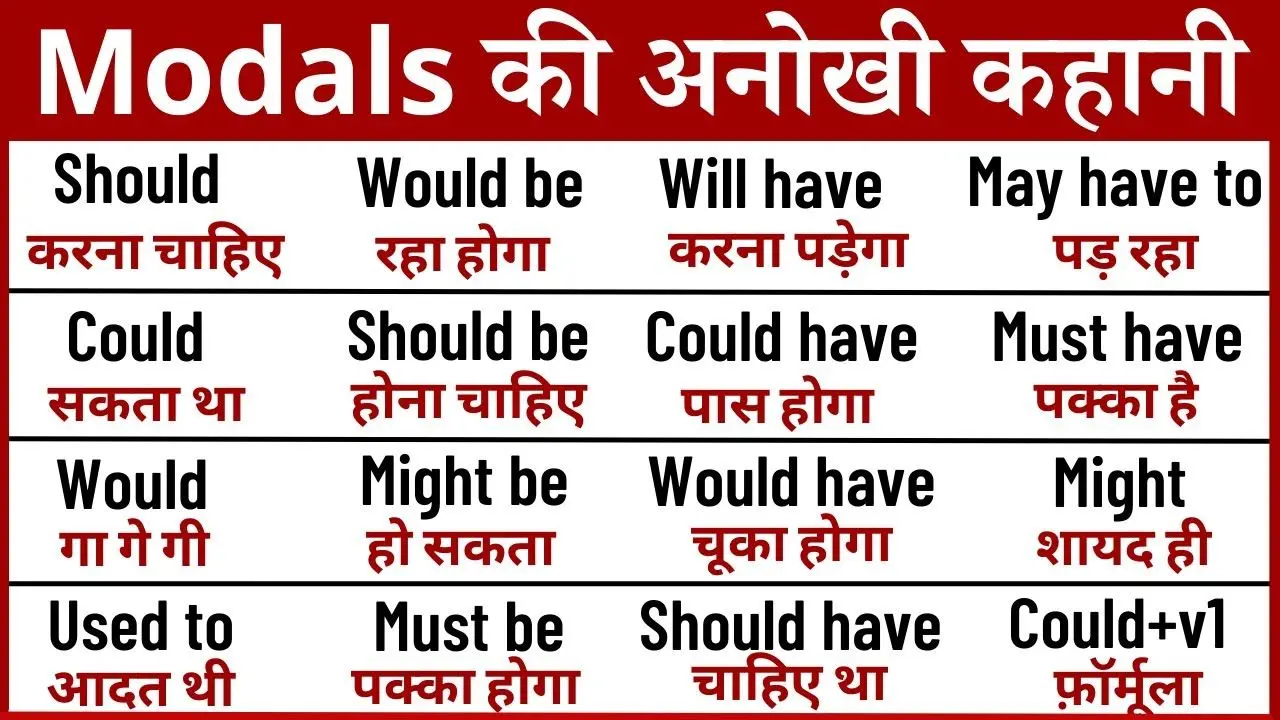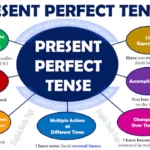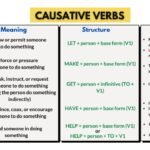Use Of Modal Verbs In Hindi: यदि आप अंग्रेजी सीखना चाहते हैं तो मॉडल क्रिया अंग्रेजी व्याकरण का सबसे महत्वपूर्ण हिस्सा है, बिना मॉडल क्रिया सीखे आप अंग्रेजी नहीं सीख पाएंगे। प्रत्येक क्षेत्र में मॉडल क्रिया आपकी अंग्रेजी भाषा और आपके व्याकरण को बेहतर बनाने में मदद करती है, मॉडल क्रिया हमेशा अंग्रेजी पाठ्यक्रम में उपयोग की जाती है, तो चलिए कैन के बारे में बात करते हैं, आज हम कैन के बारे में जानेंगे|
20 Model Verbs With Rules & Uses
1. Use Of Can (सकना)
“Can” का हिंदी मीनिंग “सकना” होता है, जिस भी हिंदी वाक्य के अंत में”सकता है ” “सकती है” या “सकते है” लगा रहता है, वहा पे “Can” का उपयोग किया जता है|
मॉडल क्रियाओं के विभिन्न प्रकार हैं लेकिन आज हम कैन के बारे में चर्चा करेंगे, कैन एक मॉडल क्रिया है, इसका अर्थ है आशा / संभावना। जैसे मैं बाजार जा सकता हूँ, यह संभावना है कि वह बाजार जा सकती है लेकिन हो सकता है कि वह बाजार न जा सके।
Examples :
- He can speak English fluently. | वह अंग्रेज़ी बोल सकता है।
- She can solve complex math problems. | वह जटिल गणित समस्याओं को हल कर सकती है।
- They can visit us tomorrow. | वे कल हमें मिलने आ सकते हैं।
- I can cook delicious food. | मैं स्वादिष्ट खाना पका सकता हूँ।
- The machine can operate automatically. | मशीन स्वचालित रूप से काम कर सकती है।
- He can play the piano very well. | वह पियानो बहुत अच्छे से बजा सकता है।
- She can run a marathon. | वह मैराथन दौड़ सकती है।
- They can complete the project on time. | वे समय पर परियोजना पूरी कर सकते हैं।
- We can learn a lot from this experience. | हम इस अनुभव से बहुत कुछ सीख सकते हैं।
- The doctor can treat this illness effectively. | डॉक्टर इस बीमारी का प्रभावी उपचार कर सकते हैं।
2. Use of Could: (सकता था)
Could is used As Past Ability, Could is used As Possibility , Could is used As Polite Request and Suggestion: , Could is used As Conditional Statement (Could का प्रयोग भूतकाल की योग्यता के रूप में किया जा सकता है, Should का प्रयोग सम्भावना के रूप में किया जा सकता है, Should का प्रयोग विनम्र अनुरोध और सुझाव के रूप में किया जा सकता है:, Should का प्रयोग सशर्त कथन के रूप में किया जा सकता है)
Examples:
- When I was young, I could run very fast. | जब मैं छोटा था, मैं बहुत तेज दौड़ सकता था।
- She could speak five languages fluently. | वह पांच भाषाओं में बोल सकती थी।
- They could have arrived earlier if they had left on time. | अगर वे समय पर निकलते, तो वे पहले पहुँच सकते थे।
- He could play the guitar when he was younger. | जब वह छोटा था, तब वह गिटार बजा सकता था।
- I could hear the sound of footsteps outside. | मुझे बाहर के पैर की आवाज़ सुनाई दी।
- She could have won the race, but she fell just before the finish line. | वह दौड़ में जीत सकती थी, पर वह फिनिश लाइन से थोड़ी देर पहले गिर गई।
- They could go to the concert if they get tickets in time. | अगर वे समय पर टिकट प्राप्त करते हैं, तो वे कॉन्सर्ट में जा सकते हैं।
- We could see the stars clearly from the mountain top. | हम पहाड़ी के शीर्ष से सितारे स्पष्ट देख सकते थे।
- He could have been a doctor if he had studied medicine. | अगर उसने चिकित्सा पढ़ी होती, तो वह डॉक्टर बन सकता था।
- She could have baked a cake if she had all the ingredients. | अगर उसके पास सभी सामग्री होती, तो वह एक केक बना सकती थी।
3. Use of May (शायद या संभावना)
May is Used To Show A Strong Possibility, To get Permission (In Formal May), To Give Permission (May का प्रयोग प्रबल संभावना दर्शाने के लिए, अनुमति प्राप्त करने के लिए, अनुमति देने के लिए किया जाता है)
Keep in mind that I may show you the possible ways to give you introspective strategies before “Do you think” you should do it using an affirmative structure
Examples:
- It may rain later today. | आज शाम को बारिश हो सकती है।
- You may have a chance to meet him tomorrow. | कल तुम्हें उससे मिलने का मौका मिल सकता है।
- May I come in, please? | क्या मैं अंदर आ सकता हूँ, कृपया?
- She may be at home now. | वह अभी घर पर हो सकती है।
- It may take some time to finish the project. | परियोजना को समाप्त करने में कुछ समय लग सकता है।
- May I use your phone? | क्या मैं आपका फोन उपयोग कर सकता हूँ?
- You may be right about that. | इसके बारे में तुम सही हो सकते हो।
- She may have forgotten about our meeting. | उसने हमारी मुलाकात के बारे में भूल सकती है।
- May we have your attention, please? | क्या हमें आपका ध्यान मिल सकता है, कृपया?
- He may need some help with his homework. | उसे अपने होमवर्क में कुछ मदद की आवश्यकता हो सकती है।
4. Use Of Might (कम संभावना)
To Show A Weak Possibility, As The Past Form Of May, To Show Regret, (This structure shows that the subject had the possibility of doing some work in the past but regret is being expressed due to not completing it), To Show The Target Of A Past Action with Also That . (एक कमजोर संभावना के लिए , अफसोस दिखाने के लिए
, (यह संरचना दर्शाती है कि विषय के पास अतीत में कुछ काम करने की संभावना थी लेकिन इसे पूरा नहीं करने के कारण अफसोस व्यक्त किया जा रहा है, इसके साथ ही एक पिछली कार्रवाई का लक्ष्य दिखाने के लिए।)
Examples :
- She might visit us next week. | वह अगले हफ्ते हमारे पास आ सकती है।
- It might rain later in the evening. | शाम को बाद में बारिश हो सकती है।
- He might have missed the bus. | उसने बस को छूक सकता है।
- They might arrive early if they leave now. | अगर वे अभी निकलते हैं, तो वे जल्दी पहुँच सकते हैं।
- She might have forgotten to call him. | शायद उसने उसे फोन करना भूल गई हो।
- It might take a few days to get the results. | परिणाम प्राप्त करने में कुछ दिन लग सकते हैं।
- They might need more time to finish the project. | उन्हें परियोजना समाप्त करने के लिए और समय की आवश्यकता हो सकती है।
- He might have hurt his leg during the game. | उसने खेल के दौरान अपनी टांग को चोट पहुँचाई हो सकती है।
- This might be the best option available. | यह सबसे अच्छा विकल्प हो सकता है जो उपलब्ध है।
- She might not have received your message yet. | शायद उसे अभी तक आपका संदेश पहुँचा नहीं हो।
5. Use of Would (ना पसंद करूँगा, चाहूँगा)
शब्द “would” अंग्रेजी में एक मोडल सहायक क्रिया है। इसका उपयोग विभिन्न विचारों को व्यक्त करने के लिए किया जाता है जैसे कि इच्छा, दृढ़ संकल्प, अतीत में भविष्य, काल्पनिक परिस्थितियाँ, विनम्र अनुरोध या प्रस्ताव, और अतीत में आदतन क्रियाएँ। यहाँ इसके कुछ प्राथमिक उपयोग दिए गए हैं|
Examples :
- He would always help his friends. | वह हमेशा अपने दोस्तों की मदद करेगा।
- She would love to visit Paris someday. | उसे कभी-कभी पेरिस घूमने का बहुत मन है।
- They would go for a walk every evening. | वे हर शाम सैर के लिए जायेंगे।
- I would like a cup of coffee, please. | मुझे एक कप कॉफ़ी चाहिए, कृपया।
- He said he would call me later. | उसने कहा वह बाद में मुझे कॉल करेगा।
- She would always sing in the shower. | वह हमेशा शौचालय में गाती रहती थी।
- They would have won the game if they had played better. | अगर वे बेहतर खेलते, तो वे खेल जीत सकते थे।
- I would have helped you if you had asked earlier. | अगर तुम पहले माँगते, तो मैं तुम्हारी मदद कर देता।
- She would often visit her grandmother on weekends. | वह अक्सर अपनी दादी को सप्ताहांत पर मिलने जाती थी।
- He would never forget her birthday. | वह कभी भी उसका जन्मदिन भूला नहीं होता।
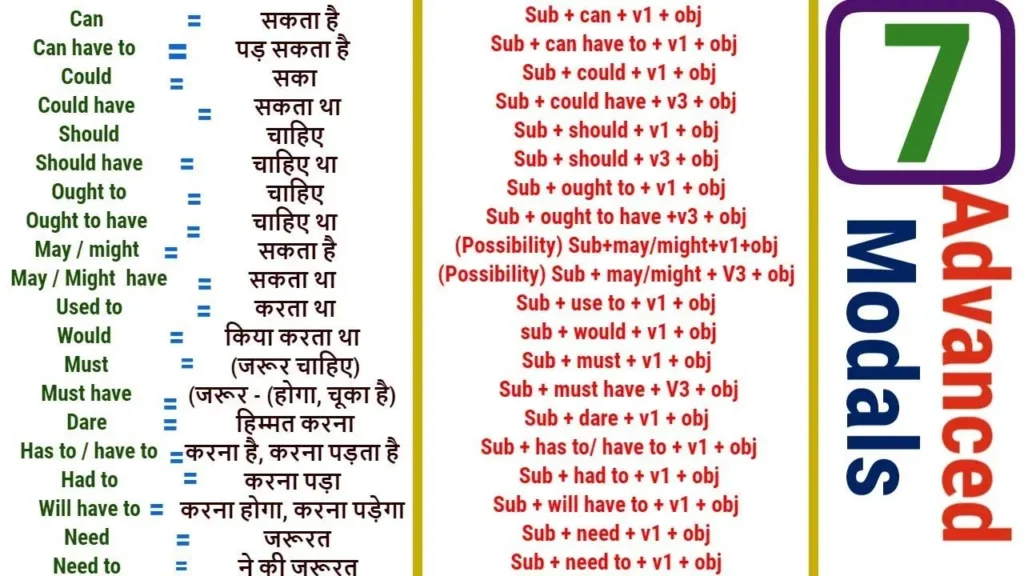
6. Use Of Should (चाहिए / सलाह)
जिस हिंदी वाक्यों के क्रिया के अंत में “चाहिए” रहता है, उस वाक्य के लिए Should का प्रयोग किया जाता है|
“चाहिए” आम तौर पर दायित्व, कर्तव्य, अपेक्षा या सलाह को व्यक्त करता है। इसका प्रयोग अक्सर यह इंगित करने के लिए किया जाता है कि किसी दिए गए परिस्थिति में क्या करना सही माना जाता है या कार्रवाई का सही तरीका क्या है। उदाहरण के लिए, “आपको अपनी परीक्षाओं के लिए अध्ययन करना चाहिए” का तात्पर्य है कि यह सलाह दी जाती है या अपेक्षित है कि आप अच्छा प्रदर्शन करने के लिए अध्ययन करें।
Should एक मोडल क्रिया है, जिसका उपयोग सलाह या सुझाव, इच्छाएँ, सुझाव के लिए शर्त और पीआर समीकरण आदि को दर्शाने के लिए किया जाता है।
Examples :
- You should eat healthy food for better health. | आपको अच्छे स्वास्थ्य के लिए स्वस्थ भोजन करना चाहिए।
- He should arrive by noon. | वह दोपहर से पहले आ जाना चाहिए।
- They should study hard for the exam. | उन्हें परीक्षा के लिए मेहनत करनी चाहिए।
- She should call her parents more often. | उसे अपने माता-पिता को अक्सर फोन करना चाहिए।
- We should leave now to avoid traffic. | हमें अब जाना चाहिए ताकि यातायात से बचा जा सके।
- You should have told me earlier. | तुम्हें मुझे पहले बता देना चाहिए था।
- He should be more careful while driving. | उसे गाड़ी चलाते समय और सावधान रहना चाहिए।
- She should have finished her homework by now. | उसे अब तक अपने होमवर्क को समाप्त कर लेना चाहिए था।
- They should ask for help if they need it. | उन्हें अगर ज़रूरत है तो मदद मांगनी चाहिए।
- You should take care of your health. | आपको अपने स्वास्थ्य का ध्यान रखना चाहिए।
7. Use Of Need (जरुरत)
In need and dare sentences, both auxiliary verb and main verb are appropriate in phrase. Atah comes in the form of auxiliary verb or need net athwart dare net while as main verb they are shown in tense pattern. ज़रूरत और हिम्मत वाले वाक्यों में सहायक क्रिया और मुख्य क्रिया दोनों ही वाक्यांश में उपयुक्त हैं। अता सहायक क्रिया या ज़रूरत नेट या हिम्मत नेट के रूप में आती है जबकि मुख्य क्रिया के रूप में उन्हें काल पैटर्न में दिखाया जाता है।)
Examples :
- He needs to finish the report by tomorrow. | उसे कल तक रिपोर्ट समाप्त करनी होगी।
- She needs help with her homework. | उसे अपने होमवर्क में मदद की आवश्यकता है।
- They need to make a decision soon. | उन्हें जल्दी से एक निर्णय लेना होगा।
- You need to ask for permission before leaving. | जाने से पहले आपको अनुमति मांगनी चाहिए।
- We need to plan our trip carefully. | हमें अपनी यात्रा की योजना ध्यान से बनानी होगी।
- He needed to buy groceries yesterday. | उसे कल किराना सामान खरीदना चाहिए था।
- She needs to practice more to improve. | उसे सुधारने के लिए और अधिक प्रैक्टिस करनी चाहिए।
- They need to be more responsible. | उन्हें और ज़िम्मेदार होना चाहिए।
- You need to focus on your studies. | आपको अपनी पढ़ाई पर ध्यान देना चाहिए।
- She needed to rest after a long day at work. | काम के लंबे दिन के बाद उसे आराम करना चाहिए था।
8. Dare: (जरुरत)
ज़रूरत और हिम्मत वाले वाक्यों में, सहायक क्रिया और मुख्य क्रिया दोनों ही वाक्यांश में उपयुक्त हैं। अताह सहायक क्रिया या ज़रूरत नेट अथवा हिम्मत नेट के रूप में आता है जबकि मुख्य क्रिया के रूप में उन्हें काल पैटर्न में दिखाया जाता है।)
Need” and “dare” are semi-modal verbs in English, meaning they can function as both main verbs and auxiliary (or helping) verbs. Here are their uses and examples:(“ज़रूरत” और “हिम्मत” अंग्रेज़ी में अर्ध-मोडल क्रियाएँ हैं, जिसका अर्थ है कि वे मुख्य क्रिया और सहायक (या सहायक) क्रिया दोनों के रूप में कार्य कर सकती हैं। यहाँ उनके उपयोग और उदाहरण दिए गए हैं:)
Examples:
- He dare not speak in front of the principal. | उसे प्रिंसिपल के सामने बोलने की हिम्मत नहीं होती।
- She dared to climb the highest peak. | उसने सबसे ऊँचे शिखर को चढ़ने की हिम्मत की।
- They dared to challenge the champion. | उन्होंने विजेता को चुनौती देने की हिम्मत की।
- You dare not ignore your responsibilities. | आप अपनी जिम्मेदारियों को नज़रअंदाज़ नहीं कर सकते।
- We dared to dream big. | हमने बड़े सपने देखने की हिम्मत की।
- He dared to question the decision. | उसने निर्णय पर सवाल करने की हिम्मत की।
- She dared to try something new. | उसने कुछ नया करने की हिम्मत की।
- They dared to explore the unknown. | उन्होंने अज्ञात की खोज करने की हिम्मत की।
- You dared to challenge the authority. | आपने सत्ता को चुनौती देने की हिम्मत की।
- She dared to confront her fears. | उसने अपने डरों से सामना करने की हिम्मत की।
9. Across (में पर / उस पार)
Across का उपयोग दो जगहों पर किया जाता है, “में पर” जिसका प्रयोग इंशान के किसी बॉडी पार्ट के लिए किया जता है, और दुसरा मतलब होता उस पार, यानी की किसी चीज के आर पार जाना|
Examples:
- The scar runs across his face. | निशान उसके चेहरे में पर है।
- He swam across the river. | उसने नदी के उस पार तैरा।
- She walked across the street. | वह सड़क के उस पार चली गई।
- The bridge goes across the valley. | पुल घाटी के उस पार जाता है।
- There are lines drawn across the paper. | कागज पर रेखाएं खींची गई हैं।
- The birds flew across the sky. | पक्षी आकाश के उस पार उड़ गए।
- He ran across the field. | वह मैदान के उस पार दौड़ा।
- They built a tunnel across the mountain. | उन्होंने पहाड़ के उस पार सुरंग बनाई।
- The cat jumped across the fence. | बिल्ली बाड़ के उस पार कूदी।
- We need to get across this point. | हमें इस बिंदु को में पर लाना है।
10. After (के बाद)
After का उपयोग “के बाद” के रूप के किया जाता है, यानी की किसी काम को पूरा कर लेने के बाद|
Examples:
- I will call you after the meeting. | मैं बैठक के बाद आपको कॉल करूंगा।
- She went home after school. | वह स्कूल के बाद घर गई।
- He cleaned up after dinner. | उसने रात के खाने के बाद सफाई की।
- They left after the party. | वे पार्टी के बाद चले गए।
- We will discuss this after lunch. | हम इसे दोपहर के खाने के बाद चर्चा करेंगे।
- She took a nap after work. | उसने काम के बाद झपकी ली।
- He apologized after the argument. | उसने बहस के बाद माफी मांगी।
- They met up after years. | वे सालों के बाद मिले।
- She felt better after resting. | आराम के बाद वह बेहतर महसूस कर रही थी।
- We will go there after breakfast. | हम नाश्ते के बाद वहां जाएंगे।
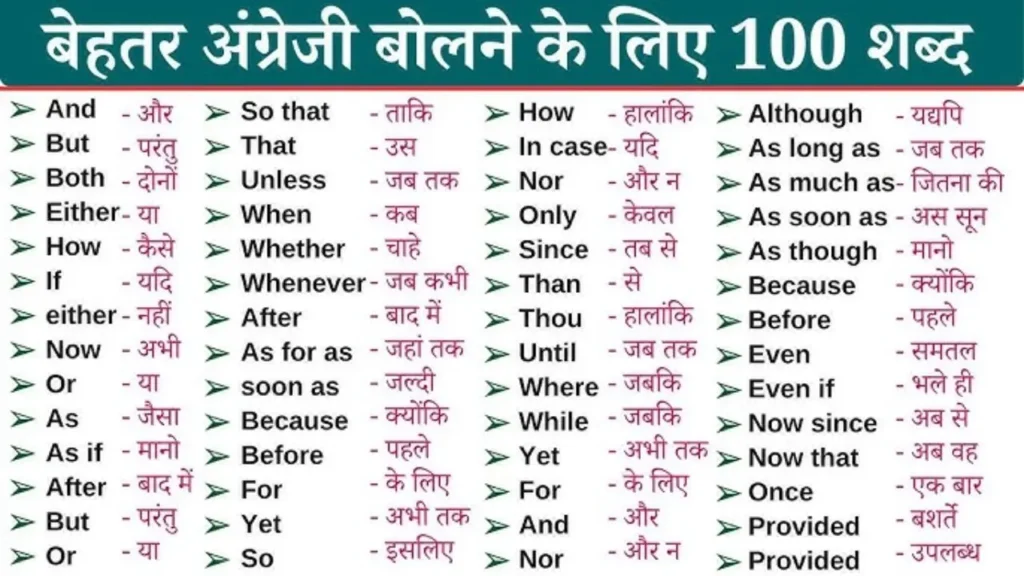
11. Between (के बिच)
इसका प्रयोग “के बिच में” के लिए किया जाता है, यानी की दो वस्तुए या चीजो के बिच|
Examples:
- The keys are between the books. | चाबियां किताबों के बीच हैं।
- He stood between his friends. | वह अपने दोस्तों के बीच खड़ा था।
- The shop is between the bank and the library. | दुकान बैंक और पुस्तकालय के बीच है।
- She was caught between a rock and a hard place. | वह एक कठिन परिस्थिति के बीच फंस गई थी।
- There is a narrow path between the trees. | पेड़ों के बीच एक संकरा रास्ता है।
- The discussion was between two leaders. | चर्चा दो नेताओं के बीच थी।
- He felt torn between loyalty and duty. | वह निष्ठा और कर्तव्य के बीच फंसा हुआ महसूस कर रहा था।
- She divided the candy between the children. | उसने बच्चों के बीच मिठाई बांटी।
- The argument was between neighbors. | बहस पड़ोसियों के बीच थी।
- They negotiated between themselves. | उन्होंने अपने बीच बातचीत की।
12. Among (में / के बिच)
Among का प्रयोग दो से अधिक person या चीज के बिच की जगत को दर्शाने के लिए किया जाता है|
Examples:
- He found his pen among the books. | उसे अपनी कलम किताबों के बीच मिली।
- She is popular among her friends. | वह अपने दोस्तों के बीच लोकप्रिय है।
- There were flowers among the grass. | घास के बीच फूल थे।
- The secret is safe among us. | राज़ हमारे बीच सुरक्षित है।
- He sat among the audience. | वह दर्शकों के बीच बैठा था।
- She was lost among the crowd. | वह भीड़ में खो गई थी।
- The treasure is hidden among the ruins. | खजाना खंडहरों के बीच छिपा हुआ है।
- They chose a leader from among themselves. | उन्होंने अपने बीच से एक नेता चुना।
- There was a sense of unity among the team. | टीम के बीच एकता की भावना थी।
- He distributed the gifts among the children. | उसने बच्चों के बीच उपहार बांटे।
13. Behind (पीछे / पीछे की और)
Behind का प्रयोग पीछे या पीछे की चीजो को दर्शाने के लिए किया जाता है|
Examples:
- The cat hid behind the curtain. | बिल्ली परदे के पीछे छिप गई।
- She left her bag behind the door. | उसने अपना बैग दरवाजे के पीछे छोड़ दिया।
- He is standing behind the tree. | वह पेड़ के पीछे खड़ा है।
- The car is parked behind the building. | कार इमारत के पीछे खड़ी है।
- She looked behind her. | उसने पीछे मुड़कर देखा।
- They were hiding behind the rocks. | वे चट्टानों के पीछे छिपे हुए थे।
- The truth was hidden behind lies. | सच झूठ के पीछे छिपा हुआ था।
- He walked behind his boss. | वह अपने बॉस के पीछे चला।
- She fell behind in her studies. | वह अपनी पढ़ाई में पीछे रह गई।
- The team was left behind in the race. | टीम दौड़ में पीछे रह गई।
14. Beside (के अलावा)
Beside का प्रयोग के अलावा या के बिना के रूप में किया जता है|
Examples:
- He sat beside his friend. | वह अपने दोस्त के बगल में बैठा।
- The lamp is beside the bed. | लैंप बिस्तर के बगल में है।
- She stood beside her mother. | वह अपनी मां के बगल में खड़ी थी।
- The house is beside the river. | घर नदी के बगल में है।
- The cat sleeps beside the dog. | बिल्ली कुत्ते के बगल में सोती है।
- He placed his bag beside the chair. | उसने अपना बैग कुर्सी के बगल में रखा।
- She was standing beside me. | वह मेरे बगल में खड़ी थी।
- The school is beside the park. | स्कूल पार्क के बगल में है।
- He lives beside the church. | वह चर्च के बगल में रहता है।
- The pen is beside the notebook. | पेन नोटबुक के बगल में है।
15. During (के दौरान)
during का प्रयोग किसी कार्य के दौरान उपयोग किया जाता है|
Examples:
- She slept during the movie. | वह फिल्म के दौरान सो गई।
- He was quiet during the meeting. | वह बैठक के दौरान चुप था।
- They ate snacks during the break. | उन्होंने ब्रेक के दौरान नाश्ता किया।
- She studied during the vacation. | उसने छुट्टी के दौरान पढ़ाई की।
- He worked hard during the project. | उसने परियोजना के दौरान कड़ी मेहनत की।
- She was happy during the trip. | वह यात्रा के दौरान खुश थी।
- They were silent during the ceremony. | वे समारोह के दौरान चुप थे।
- He felt sick during the flight. | वह उड़ान के दौरान बीमार महसूस कर रहा था।
- She was attentive during the lecture. | वह व्याख्यान के दौरान ध्यानपूर्वक थी।
- He played games during the weekend. | उसने सप्ताहांत के दौरान खेल खेले।
16. By (के द्वारा)
by का प्रयोग अगर कोई कार्य किसी और के द्वारा या किसी और चीज के द्वारा हो रहा हो या फिर किया जा रहा हो उसके लिए By का प्रयोग होता है|
By का प्रयोग तीन जगहों के लिए किया जता है|
- By का प्रयोग समय को दर्शाने के लिए “तक” के रूप में किया जाता है|
- By का प्रयोग “के जरिये या से’ के रूप में किया जाता है|
- By का प्रयोग “के द्वारा” के रूप में भी किया जाता है|
एक्साम्प्लेस:
- The book was written by him. | किताब उसके द्वारा लिखी गई थी।
- She traveled by train. | वह ट्रेन से यात्रा करती थी।
- The letter was sent by mail. | पत्र डाक द्वारा भेजा गया था।
- He stood by the window. | वह खिड़की के पास खड़ा था।
- She completed the task by evening. | उसने शाम तक काम पूरा कर लिया।
- The car was repaired by a mechanic. | कार को एक मैकेनिक द्वारा ठीक किया गया था।
- She learned to swim by practice. | उसने अभ्यास के द्वारा तैरना सीखा।
- He was promoted by the manager. | उसे मैनेजर द्वारा पदोन्नत किया गया।
- They arrived by noon. | वे दोपहर तक पहुंचे।
- She achieved her goal by hard work. | उसने मेहनत से अपना लक्ष्य हासिल किया।
17. Down (निचे / निचे की और)
Down का प्रयोग निचे या निचे की और दर्शाने के लिए किया जाता है| या फिर Down का प्रयोग “के अधीन” के अधीन के रूम में भी किया जाता है, यानी की किसी चीज के अधीन होना|
Examples:
- The ball rolled down the hill. | गेंद पहाड़ी से नीचे लुढ़क गई।
- He climbed down the ladder. | वह सीढ़ी से नीचे उतरा।
- The temperature went down. | तापमान नीचे चला गया।
- She looked down at her feet. | उसने अपने पैरों की ओर नीचे देखा।
- They walked down the street. | वे सड़क पर नीचे चले।
- The sun went down. | सूरज नीचे चला गया।
- He sat down on the chair. | वह कुर्सी पर बैठ गया।
- The cat jumped down from the table. | बिल्ली मेज से नीचे कूद गई।
- She lay down on the bed. | वह बिस्तर पर लेट गई।
- They moved down the river. | वे नदी के नीचे चले गए।
18. Up (ऊपर / ऊपर की और)
ऊपर या ऊपर की गति को दर्शाने के लिए Up का प्रयोग किया जाता है|
Examples :
- The balloon went up. | गुब्बारा ऊपर चला गया।
- He climbed up the hill. | वह पहाड़ी पर चढ़ गया।
- The sun came up. | सूरज ऊपर आया।
- She looked up at the sky. | उसने आकाश की ओर ऊपर देखा।
- They walked up the stairs. | वे सीढ़ियों पर ऊपर चले।
- The temperature went up. | तापमान ऊपर चला गया।
- He stood up. | वह खड़ा हो गया।
- The cat jumped up on the table. | बिल्ली मेज पर ऊपर कूद गई।
- She woke up early. | वह जल्दी उठ गई।
- They moved up the river. | वे नदी के ऊपर चले गए।
19. Through (से होकर / भर)
through का प्रयोग किसी चीज से होकर या भर के रूप के में लिए जाता है|
Examples:
- He walked through the forest. | वह जंगल से होकर चला।
- She looked through the window. | उसने खिड़की से होकर देखा।
- They passed through the tunnel. | वे सुरंग से होकर गुजरे।
- The water flowed through the pipe. | पानी पाइप से होकर बहा।
- He learned through experience. | उसने अनुभव से होकर सीखा।
- She read the book through. | उसने किताब भर पढ़ी।
- They communicated through letters. | उन्होंने पत्रों के माध्यम से संचार किया।
- He saw her through the crowd. | उसने भीड़ से होकर उसे देखा।
- She worked through the night. | उसने रात भर काम किया।
- They drove through the city. | वे शहर से होकर चले।
20. To (से , तक, की और, पास, नजदीक, के प्रति)
To का प्रयोग से या समय को दर्शाने के लिए तक का प्रयोग करते है| To का प्रयोग की और, पास, नजदीक और के प्रति के लिए भी करते है|
Examples:
- She went to the market. | वह बाजार गई।
- He gave the book to his friend. | उसने किताब अपने दोस्त को दी।
- They traveled to India. | वे भारत गए।
- She ran to the store. | वह दुकान की ओर दौड़ी।
- He walked to the park. | वह पार्क तक चला।
- They moved to a new house. | वे एक नए घर में चले गए।
- She listened to music. | उसने संगीत सुना।
- He looked to the future. | उसने भविष्य की ओर देखा।
- They were close to the finish line. | वे फिनिश लाइन के नजदीक थे।
- She dedicated her life to teaching. | उसने अपना जीवन शिक्षण के प्रति समर्पित किया।
Read Also:
